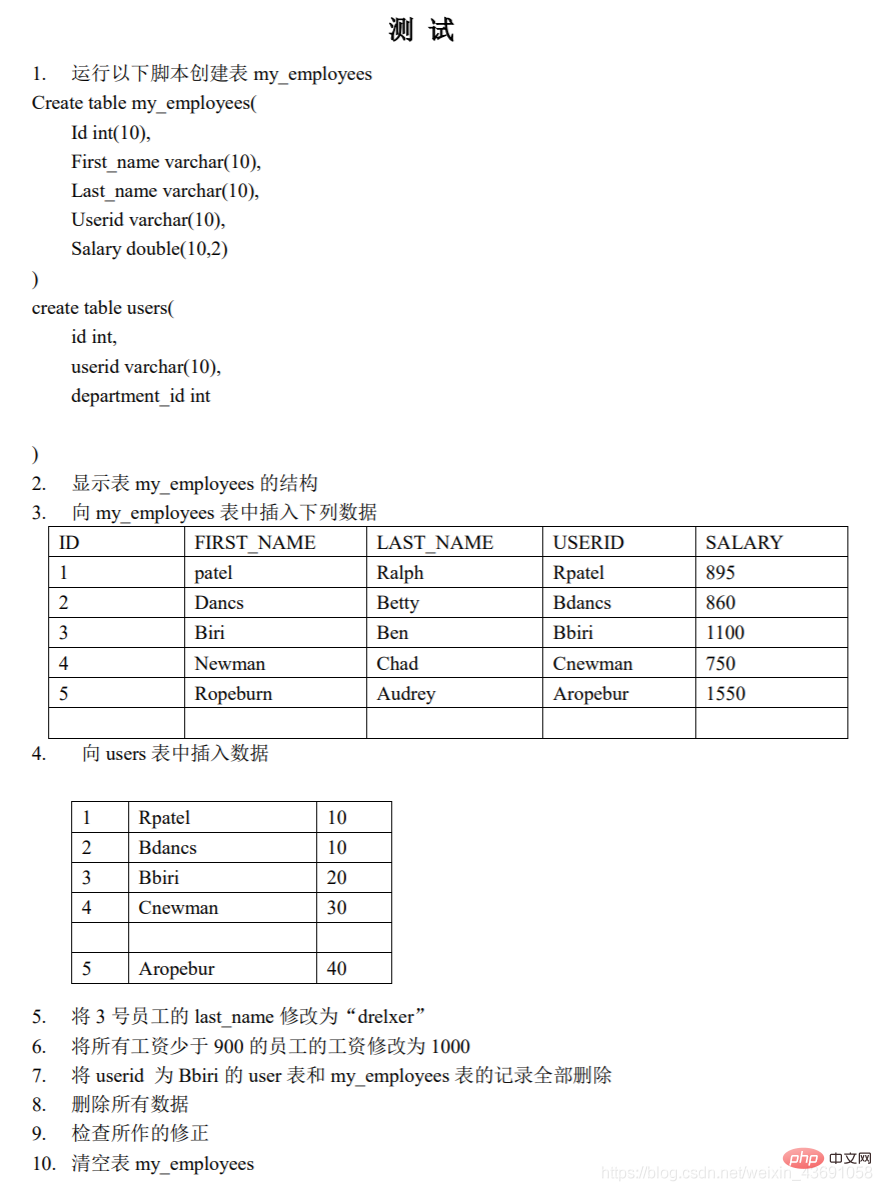MySQL Lecture 2: DML Data Operation Statements

Free learning recommendation: mysql video tutorial
##Article Directory
- 1. Insert
- 2. Modify update
- 3. Delete delete/truncate
- 4. DML statement exercises
1. Insert
Method 1:insert into table name (column name,...) values(value1,...); Method 2:
insert into table name set column name=value, column name=value...
| Whether it supports inserting multiple rows | Whether it supports subqueries | |
|---|---|---|
| √ | × | |
| √ | × |
2. Modify update
1. Modify the record syntax of a single table:update table name
set column=new value, column=new value,...
where filter condition;
update > where > ; set
update table 1 alias
[inner|left|right] join table 2 alias
on connection condition
set column=new value, column=new value,...
where filter condition;
【修改单表的记录】# 修改beautty表中姓周的女生电话为15888888888UPDATE beautySET phone='15888888888'WHERE NAME LIKE '%周%';【修改多表的记录】# 将张无忌的女朋友的电话号改为2333UPDATE boys b1JOIN beauty b2 ON b1.id=b2.boyfriend_idSET b2.phone='2333'WHERE b1.boyName='张无忌';
3. Delete delete/truncate
delete
Single table deletion:delete from table name where filter conditions
delete table 1 alias, table 2 alias
from table 1 alias
inner|left|right join table 2 alias on connection condition
where filter condition;
truncate
Clear Single table:truncate table table name;
There is no return value for truncate deletion, and there is a return value for delete deletion.
| Whether it is possible to add a where condition | Whether it can be rolled back | Is there a return value? | Efficiency | When there are auto-increasing columns in the table | |
|---|---|---|---|---|---|
| √ | √ | √ | Generally | Use delete to delete and then insert data. The self-increasing value starts from the breakpoint | |
| × | × | × | is slightly higher than delete | Use truncate to delete and then insert data, which will grow automatically The value starts from 1 |
Learned the addition, deletion and modification of DML language statements, Try to complete the following exercises:
Answer:
1. Execute the following sql statementCREATE TABLE my_employees(Id INT(10),
First_name VARCHAR(10),
Last_name VARCHAR(10),
Userid VARCHAR(10),
Salary DOUBLE(10,2)
);
CREATE TABLE users(
id INT ,
userid VARCHAR(10),
department_id INT
);
2.DESC my_employees
3.Method 1:INSERT INTO my_employees
VALUES(1,'patel','Ralph','Rpatel',895),
(2,'Dancs','Betty','Bdancs',860 ),
(3,'Biri','Ben','Bbiri',1100),
(4,'Newman','Chad','Cnewman',750),
(5, 'Ropeburn','Audrey','Aropebur',1550);
TRUNCATE TABLE my_employees;
Method 1:
INSERT INTO my_employees
SELECT 1,'patel','Ralph','Rpatel ',895 UNION
SELECT 2,'Dancs','Betty','Bdancs',860 UNION
SELECT 3,'Biri','Ben','Bbiri',1100 UNION
SELECT 4, 'Newman','Chad','Cnewman',750 UNION
SELECT 5,'Ropeburn','Audrey','Aropebur',1550;
4.INSERT INTO usersVALUE(1,'Rpatel',10),
(2,'Bdancs',10),
(3,'Bbiri',20),
(4,'Cnewman' ,30),
(5,'Aropebur',40);
5.UPDATE my_employeesSET Last_name='drelxer'
WHERE id=3;
6.UPDATE my_employeesSET salary=1000
WHERE salary
7.DELETE u,eFROM users u
JOIN my_employees e ON u.userid=e.userid
WHERE u.userid='Bbiri';
8.DELETE FROM my_employees;DELETE FROM users;
9.SELECT * FROM my_employees;SELECT * FROM users;
10.TRUNCATE TABLE my_employees;
More related free learning recommendations:mysql tutorial(Video)
The above is the detailed content of MySQL Lecture 2: DML Data Operation Statements. For more information, please follow other related articles on the PHP Chinese website!

Hot AI Tools

Undresser.AI Undress
AI-powered app for creating realistic nude photos

AI Clothes Remover
Online AI tool for removing clothes from photos.

Undress AI Tool
Undress images for free

Clothoff.io
AI clothes remover

AI Hentai Generator
Generate AI Hentai for free.

Hot Article

Hot Tools

Notepad++7.3.1
Easy-to-use and free code editor

SublimeText3 Chinese version
Chinese version, very easy to use

Zend Studio 13.0.1
Powerful PHP integrated development environment

Dreamweaver CS6
Visual web development tools

SublimeText3 Mac version
God-level code editing software (SublimeText3)

Hot Topics
 PHP's big data structure processing skills
May 08, 2024 am 10:24 AM
PHP's big data structure processing skills
May 08, 2024 am 10:24 AM
Big data structure processing skills: Chunking: Break down the data set and process it in chunks to reduce memory consumption. Generator: Generate data items one by one without loading the entire data set, suitable for unlimited data sets. Streaming: Read files or query results line by line, suitable for large files or remote data. External storage: For very large data sets, store the data in a database or NoSQL.
 How to optimize MySQL query performance in PHP?
Jun 03, 2024 pm 08:11 PM
How to optimize MySQL query performance in PHP?
Jun 03, 2024 pm 08:11 PM
MySQL query performance can be optimized by building indexes that reduce lookup time from linear complexity to logarithmic complexity. Use PreparedStatements to prevent SQL injection and improve query performance. Limit query results and reduce the amount of data processed by the server. Optimize join queries, including using appropriate join types, creating indexes, and considering using subqueries. Analyze queries to identify bottlenecks; use caching to reduce database load; optimize PHP code to minimize overhead.
 How to use MySQL backup and restore in PHP?
Jun 03, 2024 pm 12:19 PM
How to use MySQL backup and restore in PHP?
Jun 03, 2024 pm 12:19 PM
Backing up and restoring a MySQL database in PHP can be achieved by following these steps: Back up the database: Use the mysqldump command to dump the database into a SQL file. Restore database: Use the mysql command to restore the database from SQL files.
 How to insert data into a MySQL table using PHP?
Jun 02, 2024 pm 02:26 PM
How to insert data into a MySQL table using PHP?
Jun 02, 2024 pm 02:26 PM
How to insert data into MySQL table? Connect to the database: Use mysqli to establish a connection to the database. Prepare the SQL query: Write an INSERT statement to specify the columns and values to be inserted. Execute query: Use the query() method to execute the insertion query. If successful, a confirmation message will be output.
 How to fix mysql_native_password not loaded errors on MySQL 8.4
Dec 09, 2024 am 11:42 AM
How to fix mysql_native_password not loaded errors on MySQL 8.4
Dec 09, 2024 am 11:42 AM
One of the major changes introduced in MySQL 8.4 (the latest LTS release as of 2024) is that the "MySQL Native Password" plugin is no longer enabled by default. Further, MySQL 9.0 removes this plugin completely. This change affects PHP and other app
 How to use MySQL stored procedures in PHP?
Jun 02, 2024 pm 02:13 PM
How to use MySQL stored procedures in PHP?
Jun 02, 2024 pm 02:13 PM
To use MySQL stored procedures in PHP: Use PDO or the MySQLi extension to connect to a MySQL database. Prepare the statement to call the stored procedure. Execute the stored procedure. Process the result set (if the stored procedure returns results). Close the database connection.
 How to create a MySQL table using PHP?
Jun 04, 2024 pm 01:57 PM
How to create a MySQL table using PHP?
Jun 04, 2024 pm 01:57 PM
Creating a MySQL table using PHP requires the following steps: Connect to the database. Create the database if it does not exist. Select a database. Create table. Execute the query. Close the connection.
 The difference between oracle database and mysql
May 10, 2024 am 01:54 AM
The difference between oracle database and mysql
May 10, 2024 am 01:54 AM
Oracle database and MySQL are both databases based on the relational model, but Oracle is superior in terms of compatibility, scalability, data types and security; while MySQL focuses on speed and flexibility and is more suitable for small to medium-sized data sets. . ① Oracle provides a wide range of data types, ② provides advanced security features, ③ is suitable for enterprise-level applications; ① MySQL supports NoSQL data types, ② has fewer security measures, and ③ is suitable for small to medium-sized applications.







